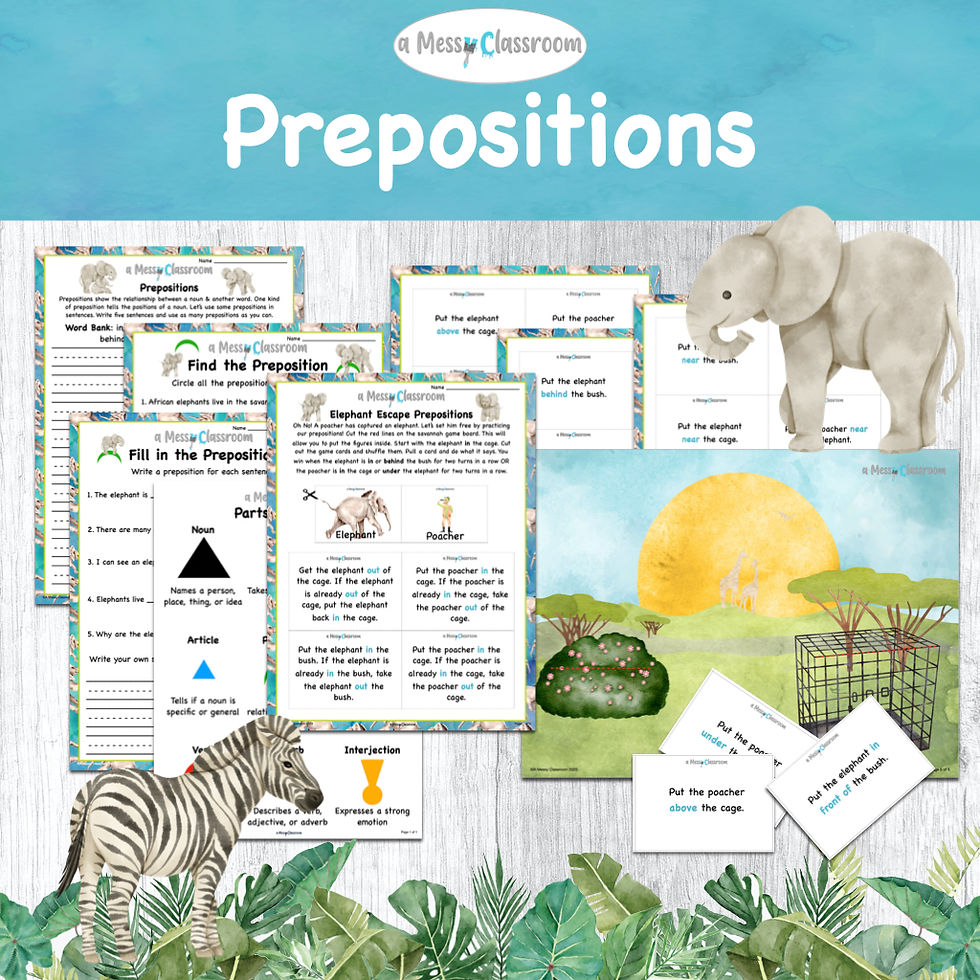Exploring Elephants: The Best Hands-On Resources for Teaching Elementary Students
- A Messy Classroom
- Jul 17, 2023
- 3 min read
Elephants are fascinating creatures that captivate the imagination of elementary students. Engaging students in hands-on learning experiences about elephants can spark their curiosity, deepen their understanding of wildlife, and foster a love for nature. In this article, we will explore the best resources for teaching elementary students about elephants in a hands-on way. These interactive and educational tools will inspire young minds and provide memorable learning experiences.

Elephant Anatomy Models and Charts
Utilize anatomical models and charts to help students visualize the unique features and body structure of elephants. These resources facilitate discussions on adaptations, skeletal systems, and the anatomy of these magnificent creatures.
Elephant Books and Literature
Introduce captivating books and literature about elephants to elementary students. Select age-appropriate texts that highlight elephant behavior, habitats, conservation, and interesting facts. Reading stories about elephants can ignite curiosity and promote empathy towards wildlife.

Elephant Conservation Websites and Videos
Explore educational websites and videos that focus on elephant conservation efforts. These resources offer insights into the challenges elephants face in the wild and raise awareness about the importance of protecting their habitats. Engage students in discussions about environmental stewardship and the significance of conservation.
Virtual Elephant Safaris
Embark on virtual field trips to elephant sanctuaries and reserves through online platforms. Virtual tours allow students to observe elephants in their natural habitats, learn about their behaviors, and understand the importance of conservation efforts firsthand.

Elephant Crafts and Art Projects
Encourage creativity by engaging students in elephant-themed crafts and art projects. Provide materials for making elephant masks, origami elephants, or elephant paintings. These hands-on activities promote fine motor skills, artistic expression, and a deeper connection to the subject matter.

Elephant Documentary Viewing
Screen age-appropriate documentaries about elephants in the classroom. Choose films that showcase their natural behaviors, social structures, and interactions with other wildlife. Afterward, engage students in discussions and encourage them to share their observations and insights.

Guest Speakers or Elephant Experts
Invite guest speakers or elephant experts to share their knowledge and experiences with elementary students. These experts can provide unique perspectives, discuss conservation efforts, and answer students' questions about elephants and their habitats.

Elephant Research Projects
Assign research projects where students can dive deeper into specific aspects of elephants, such as their diet, communication, or migration patterns. Encourage students to use a variety of sources, including books, websites, and articles, to gather information and present their findings to the class.
Elephant Adoption Programs
Connect with reputable elephant adoption programs that offer educational resources for classrooms. Through these programs, students can symbolically adopt an elephant and learn more about its life, habitat, and conservation status. This experience fosters a sense of responsibility and empathy towards these majestic animals.

Elephant-themed STEM Activities
Incorporate STEM (Science, Technology, Engineering, and Mathematics) activities with an elephant focus. For example, challenge students to design and build a model of an elephant-friendly habitat or develop a solution to protect crops from elephants in regions with human-wildlife conflicts. These activities promote critical thinking, problem-solving skills, and an understanding of the interplay between elephants and their environment.

By utilizing these hands-on resources, educators can create engaging and memorable learning experiences about elephants for elementary students. The combination of interactive models, captivating literature, virtual safaris, creative projects, and expert insights will enhance students' understanding of elephants and foster a deep appreciation for wildlife conservation. Embrace the opportunity to inspire young minds, connect them with nature, and instill a sense of stewardship for these magnificent creatures.





Comments